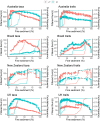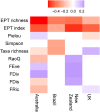Freshwater invertebrate responses to fine sediment stress: A multi-continent perspective
- PMID: 38273567
- PMCID: PMC10952627
- DOI: 10.1111/gcb.17084
Freshwater invertebrate responses to fine sediment stress: A multi-continent perspective
Abstract
Excessive fine sediment (particles <2 mm) deposition in freshwater systems is a pervasive stressor worldwide. However, understanding of ecological response to excess fine sediment in river systems at the global scale is limited. Here, we aim to address whether there is a consistent response to increasing levels of deposited fine sediment by freshwater invertebrates across multiple geographic regions (Australia, Brazil, New Zealand and the UK). Results indicate ecological responses are not globally consistent and are instead dependent on both the region and the facet of invertebrate diversity considered, that is, taxonomic or functional trait structure. Invertebrate communities of Australia were most sensitive to deposited fine sediment, with the greatest rate of change in communities occurring when fine sediment cover was low (below 25% of the reach). Communities in the UK displayed a greater tolerance with most compositional change occurring between 30% and 60% cover. In both New Zealand and Brazil, which included the most heavily sedimented sampled streams, the communities were more tolerant or demonstrated ambiguous responses, likely due to historic environmental filtering of invertebrate communities. We conclude that ecological responses to fine sediment are not generalisable globally and are dependent on landscape filters with regional context and historic land management playing important roles.
Keywords: aquatic biodiversity; community composition; conservation; ecological threshold; ecosystem function; global scale.
© 2023 The Authors. Global Change Biology published by John Wiley & Sons Ltd.
Conflict of interest statement
The authors declare no conflict of interest.
Figures




References
-
- Agra, J. , Ligeiro, R. , Heino, J. , Macedo, D. R. , Castro, D. M. P. , Linares, M. S. , & Callisto, M. (2021). Anthropogenic disturbances alter the relationships between environmental heterogeneity and biodiversity of stream insects. Ecological Indicators, 121, 107079. 10.1016/j.ecolind.2020.107079 - DOI
-
- Allen, R. C. (1999). Tracking the agricultural revolution in England. Economic History Review, 52(2), 209–235.
-
- Baker, M. E. , & King, R. S. (2013). Of TITAN and straw men: An appeal for greater understanding of community data. Freshwater Science, 32(2), 489–506. 10.1899/12-142.1 - DOI
-
- Baker, M. E. , King, R. S. , & Kahle, D. (2015). Package “TITAN2”: Threshold indicator taxa analysis . R package version 2.1.
-
- Borchers, H. W. (2019). Package ‘pracma’ . Practical numerical math functions, version 2.2.5.
MeSH terms
Grants and funding
LinkOut - more resources
Full Text Sources

